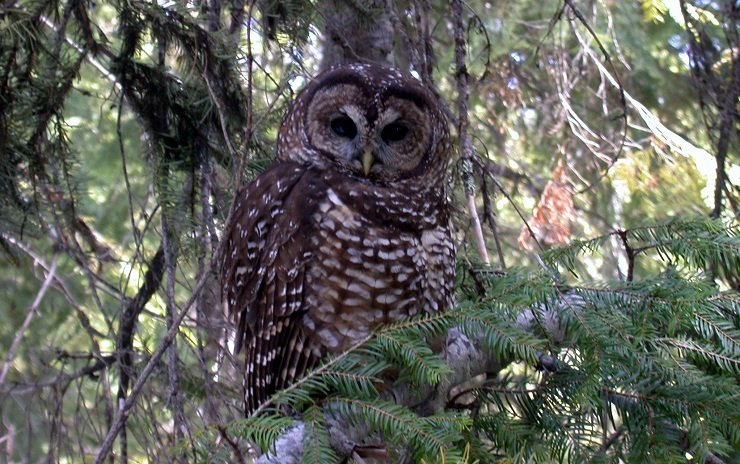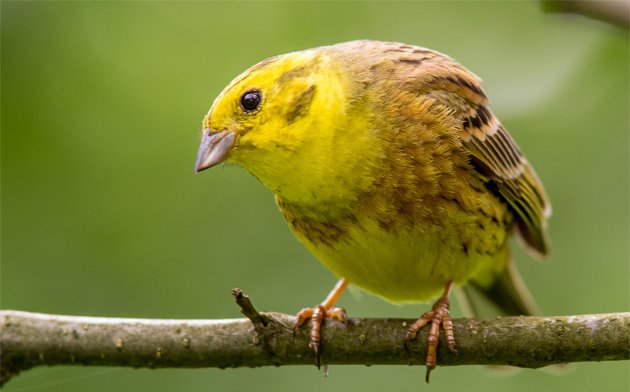
The Northern Spotted Owl is a “threatened” species under the U.S. Endangered Species Act and it was famously the subject of extensive and protracted litigation in the late 1980s and early 1990s, mostly relating to forestry management plans in the Pacific Northwest.
Although most of the threats to the Spotted Owl relate to its dwindling old growth forest habitat, it also faces potential threats from another bird. The Barred Owl has greatly expanded its range, such that it is now common in the Pacific Northwest. The Barred Owl is larger and more adaptable and it appears to out-compete Spotted Owl for food and other resources, likely causing declines in Spotted Owl populations. Indeed, due to dramatic increase, Barred Owls can outnumber Spotted Owls in their shared habitats.
For species listed under the Endangered Species Act, the U.S. Fish and Wildlife Service (FWS) generally creates a formal plan to guide recovery efforts. The most recent plan for the Spotted Owl called for experimental “removal” of Barred Owls from Spotted Owl habitat. The removal program was designed to determine whether Barred Owls were a threat to Spotted Owls, the magnitude of any such threat, and the effectiveness of removal. The plan was the subject of public comments and hearings, consultation with a bio-ethics expert, and an environmental impact statement. (A sample of this process is here.) Because the Barred Owl population is robust, FWS determined that there would not be a long term negative impact and the population would fully recover in 3-5 years.
However, the Migratory Bird Treaty Act (“MBTA”) broadly prohibits the “take” of any bird, which effectively means that a protected bird cannot be killed, harassed, or otherwise adversely impacted. In this case, FWS conceded that most removals would be “lethal” removals, meaning that Barred Owls would be “removed” by killing them. Although the MBTA’s prohibitions are broad, there are many exceptions, including “take” for scientific research. FWS argued that the proposed “taking” of Barred Owls fell within this scientific research exception and, therefore, did not violate the MBTA.
Two environmental groups — Friends of Animals and Predator Defense — disagreed and filed suit against FWS, arguing that the plan to remove the Barred Owls violated the MBTA and other environmental laws. They argued that the scientific research exception only applied to research on the animal to be taken. Thus, Barred Owls could only be taken if the research was intended to benefit the Barred Owl. Because the research here was intended to benefit the Spotted Owl, they argued that the take was improper. A federal judge in Oregon determined that there was nothing in the relevant statute or regulations that required that any “take” be for research on that species and granted FWS’s motion for summary judgment.
The environmental groups appealed to the U.S. Court of Appeals for the Ninth Circuit, but the result was the same. The appellate panel stated that the MBTA delegated to FWS the authority to draft regulations implementing the statutory permitting process. The court wrote (lightly edited for readability):
FWS has exercised the authority delegated by the MBTA to promulgate regulations governing the taking of migratory birds. Most relevant to this case is 50 C.F.R. § 21.23, which governs scientific collecting permits and under which the FWS issued the permit. Under such regulation, applications to take migratory birds for scientific or educational purposes must describe the species and number of birds to be taken, the location of collection, the purpose of the research project, and the institution to which specimens will ultimately be donated.
The unanimous panel determined that the MBTA had “few substantive conditions” and that FWS had “broad discretion” to implement the MBTA. Because there was nothing in the statute or regulations to support the “same species” argument, the court agreed with FWS that its plan was legal and affirmed the judgment of the district court. Although there are further appellate options available, any attempts to overturn a unanimous decision would face daunting odds.
Thus, FWS is free to continue its program to remove Barred Owls from Spotted Owl habitat. Of course, the courts determined the legality of the program, but did not assess the ethical issues involved in “taking” Barred Owls to protect Spotted Owls.

The cases are:
- Friends of Animals v. U.S. Fish & Wildlife Serv., 2015 U.S. Dist. LEXIS 93734, 2015 WL 4429147 (D. Or., July 16, 2015);
- Friends of Animals v. U.S. Fish & Wildlife Serv., 879 F.3d 1000 (9th Cir. 2018).
Photos: Spotted Owl by USFWS Endangered Species; Table Rock Wilderness, Oregon by BLM Oregon and Washington.




 New writers welcome – please contact us for details.
New writers welcome – please contact us for details.

















Thank you for this informative summary. I live on the Olympic Peninsula and have seen many Barred Owls, clear cuts, and logging trucks, but never a Spotted Owl.
Thank you for this very clear explanation of a complex situation.
Rarely, if ever, do courts consider “ethical” issues. Countless birds have been “taken” under the MBTA via permits by a multitude of agencies at Federal and State level for a sundry of reasons. One must question if shooting some 5,000 Barred Owls for doing what evolution dictates is the root cause of the continuing decline of the Northern Spotted Owl. For those who are in favor, let them pull the trigger upon seeing a Barred Owl.
all of these birds are amazing be sure to post more!
The ethical dilemma of whether to kill another species to save another is complex. In terms of declining populations, it is not hard to make sense of the need to remove the offending predator or competitor. This is essentially the argument to remove feral cats. It is also the argument to remove other feral wildlife.
It becomes more complex as the issue becomes more nuanced. For example, in the case of Brown-headed Cowbirds, whose original habitat consisted of the great plains and who lived alongside Bison. These birds were introduced to new territories via cattle ranching. Today, many species of small songbirds are ill-equipped and have no tactical behaviors to prevent predation of their babies. Yet, Cowbirds remain protected across the U.S.
As an avian rehabilitator, I have my own take on this issue. My work is based on the ethics of inherent value – each bird is seen as an individual, not just a member of a ‘population.’ Yet, I make choices that clearly are population-ethics decisions. For example, I do not rescue starlings or house sparrows. Inherent value is the foundation of most animal rights ethics arguments. And it is valuable because it employs empathy.
Humans make ethical choices all of the time, whether they realize it or not. Allowing endangered species to hit windows and increasing predator populations is feeding in our yards, where small songbirds are also invited. Notably, our fish and wildlife agencies restrict hunting to protect wildlife species. And, in the case of feral horses, they regulate those too.
If our policies were entirely based on inherent value, many more species would be in decline today. Science shows that the Barred Owl does negatively impact the Spotted Owl. So, at least in numbers, it makes sense to assist this imperiled bird as much as we can. Evolution has little to do with old-growth logging and unnatural invasive species. These are human-caused impacts. Humans should be ethically bound to repair impacts caused by their species.
Should we shoot Barred Owls? Should we shoot cats? Let’s not forget how emotionally hard it will be for those poor fish and wildlife souls to do this action. Many of these people got into what they do because they love wildlife.
Finally, there is a subconscious (or not) societal preference for the charismatic species of birds. Bald Eagles are wiping out Common Murre babies every summer on the coast. Yet, those birds are allowed to remain there because of the unpopularity of culling eagles. So, one day we will wake up to find just a few of the Murres.
In sum, do we take out the Barred Owl? Sadly, I have to agree with the plan. Having received Barred Owl patients, I acknowledge how amazing they are. It is a tortuous decision that I am sure no one has made lightly.